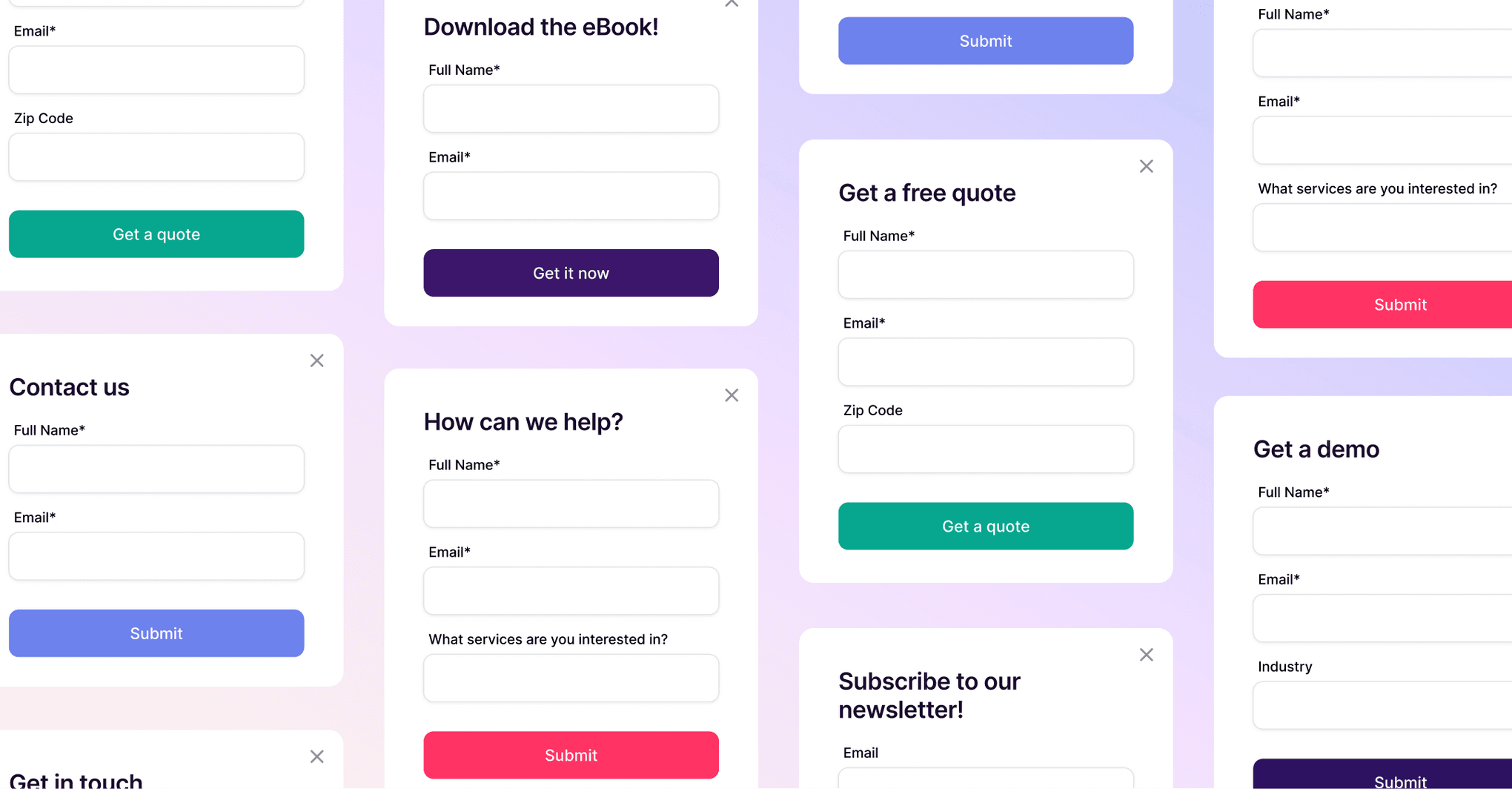Jemicah Marasigan
Content Marketing Manager
Forms are everywhere. Want Wi-Fi at the airport? Fill out a form. Want to sign up for that “exclusive webinar”? Form. Order pizza online at 11 p.m.? Yep… you may need to order with a form.
Forms are basically the internet’s secret handshake. You can’t get access to much of anything without one. And businesses love them too, because they’re the easiest way to get customer info.
But here’s the catch: forms are great at grabbing data… they’re not so great at what comes after.
Collecting data is great, but what happens next?
Here’s the problem with most data collection forms: the second someone hits submit, the momentum dies. The info gets stuck in a spreadsheet, buried in an inbox, or trapped in a tool that doesn’t talk to the rest of your workflow.
For agencies and consultants, that’s a killer. What should be the start of a smooth client relationship turns into a bottleneck of manual steps: copying, pasting, forwarding, reminding. Meanwhile, leads cool off before anyone follows up, intake details get scattered across emails, and opportunities stall before they even get logged.
Even if the data eventually makes its way into your CRM, if it doesn’t trigger anything, you’re still losing time. Automations are what keep the wheels turning. A new client intake should automatically assign tasks. An event registration should trigger a follow-up email. A project request should create reminders or tags for the right team.
Without that layer, you’re just collecting data, you’re not acting on it.
That’s why the real shift comes when your forms don’t just capture information, they plug directly into your customer relationship management (CRM) platform and trigger the automations that move work forward.
And when that happens, responses don’t sit idle. They become structured records (leads, contacts, or even pipeline opportunities) that your team can start working with immediately.
The 5 ways to use data-collection forms to build relationships
Every form submission is more than just information, it’s the start of a potential relationship.
When your forms connect directly to your CRM, that interest doesn’t get lost. It instantly becomes something actionable: a lead, a contact, or even a new opportunity in your pipeline.
And this is where the fun begins — because once your forms are powering your CRM, the use cases open up fast.
1. Use forms for client intake that actually works
Ask any agency founder or account manager and they’ll tell you: intake is where chaos likes to hide.
A client signs on, everyone’s excited… and then the questions start. Who’s the main contact? What’s the project scope? Do they have a budget range? Did anyone ask about deadlines yet?
Suddenly, your inbox is overflowing. Some details are buried in a forwarded email, others scribbled in a Slack thread, and a few never make it anywhere at all. Before long, you’re piecing together a project kickoff from scraps.
But with forms connected to your CRM, intake looks totally different.
The moment a client signs, you send them a simple intake form — and all the questions in one place. They fill it out, then the responses land directly in your CRM, where they automatically create an opportunity in your “New Clients” pipeline.
Every detail is right there: contact info, goals, budget, custom fields… whatever you’ve set up.
And because Copper CRM can trigger automations the moment a form creates a record, tasks get assigned, follow-ups go out, and nothing falls through the cracks while you’re still celebrating the new client.
The difference? Instead of wasting hours chasing details, your team starts projects with everything they need, neatly organized and ready to go.
Intake becomes a process you can actually rely on (a.k.a. consistent, repeatable, and stress-free).
And, for service-based businesses, that consistency is what keeps clients impressed and operations scalable.
2. Keep the conversation going after events and webinars
Events and webinars are amazing for generating interest. They’re also notorious for creating “data dead zones.” People register, but their info ends up stuck in Zoom, Eventbrite, or a Google Sheet that someone meant to import into your CRM.
By the time sales sees the list, the excitement from the event is long gone.
With CRM-connected data collection forms, you cut that lag time out completely. This is one of the clearest examples of how to use data collection forms to turn simple registrations into actual leads.
Picture this: you’re hosting a “Future of Marketing 2025” webinar. Attendees sign up through your form, and each registration creates a lead record instantly in your CRM.
Owners are assigned, details are logged, and automations kick in immediately: tasks, reminders, even emails. Your sales team can follow up the same day without chasing a registration list.
Better yet, you don’t have to mess with complicated embeds if you don’t want to.
Every form has its own shareable link (we’ll get into that more later), so you can post it on your event page, in a promo email, or even in a social post.
The point is, those sign-ups stop being just “registrations” and start being opportunities. And your team never loses the chance to connect while interest is still fresh.
Get the latest from our blog every month
3. Strengthen trust by keeping project requests organized
If you’re juggling multiple clients at once (hello, agency life… but also, who isn’t?), you know requests come in from everywhere. Some clients email. Others Slack. A few send notes through whatever platform they prefer.
The result? Scattered details, vague requests, and lots of time wasted tracking things down.
A dedicated request form fixes this. Clients submit project details in one place: scope, budget, timeline, priority — basically, whatever you need to manage work effectively. And because the form is tied to your CRM, each submission creates an opportunity in your “Projects” pipeline.
Now, instead of juggling multiple sources of truth, you’ve got one.
Every request is logged, structured, and visible. Nothing slips through, and every project starts with the right info from the start.
For agencies and consultants, this goes way beyond efficiency. When their requests don’t vanish into the void and are actually acted on quickly, it sends a clear signal: “we’re on top of it.”
And that kind of trust is what keeps clients sticking around.
4. Use data collection forms to simplify recruitment and internal workflows
Scaling an agency or consultancy isn’t just about landing new clients — it’s about building the right team and keeping operations humming. That’s where Copper forms can help internally.
Take recruitment, for example. Instead of juggling resumes over email or cobbling together Google Forms, you could create a form for applications. Each submission automatically becomes a lead in a “Hiring” pipeline, making it easy to track candidates through the stages, like potential candidates, interview (rounds one or more), the offer stage, and official hire stage.
Or maybe you’re collecting vendor information, internal feedback, or team requests. With CRM-connected data collection forms, all of that flows into a dedicated pipeline too. Plus, with automations in play, a new project request can instantly create tasks or trigger workflows, so clients see action right away, and not silence.
For agencies and media brands, this is a smart way to use data collection forms beyond sales.
5. Grow your audience with newsletter and company update sign-ups
Not every relationship starts with a big client contract or a new project. Sometimes it starts with something simple: a prospect raising their hand to stay in the loop.
That’s why having a form on your website for newsletters, announcements, or company updates is such a powerful (and often overlooked) use case.
Instead of capturing email addresses in a random spreadsheet that marketing has to wrangle later, form submissions feed straight into your CRM and even Mailchimp. That means every new subscriber isn’t just another name on a list, they’re a real contact in your system, ready to be nurtured over time.
For agencies and media brands, this turns your newsletter list into more than just a broadcast channel. You’re actually building a pipeline of engaged people who already know your voice, follow your content, and are more likely to convert when the timing’s right.
And since Copper lets you add subscribers directly into the right list or segment, you can keep everything organized from day one.
Making forms actually work for you (the Copper way)
By now, it’s pretty clear: forms can do a lot more than just collect data.
They can shape how you bring on new clients, how you follow up after events, how you manage project requests, and even how you run your own team. Especially when the data they capture triggers automations instantly. But all of that only works if the information is going straight into your CRM.
If your forms aren’t syncing to your CRM? It might be time to reassess your tech stack.
This is exactly why we built Pipeline Forms into Copper. They’re not a bolted-on tool or an integration that constantly needs babysitting. They’re native to your CRM, which means everything you capture is immediately put to work.
Why Copper Forms
There are a lot of ways to add forms to your website, but most tools stop at capturing names and email addresses. Copper Forms are different because they’re built right into your CRM, which means the data you collect is immediately usable and tied to the relationships you’re managing.
Native to your CRM: You don’t have to rely on Zaps, plug-ins, or complicated handoffs between tools. Submissions flow directly into Copper, becoming leads, people, or opportunities the moment someone hits submit. That’s one less integration to maintain—and one less place for things to break.
Flexible: Forms aren’t locked to your website. Because every form has its own shareable link, you’re not stuck embedding them only on your website. You can drop them in an onboarding email, send them in a DM, post them on social media, or even pull one up on a tablet at a live event.
Structured pipeline records: Other form tools usually stop at “new contact created.” Copper lets you go deeper by creating structured records inside your pipelines. That means you can capture project scope, budget, or custom fields right from the start—information your team actually needs to move work forward.
Automations: Submissions don’t just sit in Copper, they trigger automations. Tasks get assigned, stage-change emails go out, reminders fire. Work moves forward without anyone having to push it along.
The result is forms that don’t just sit on top of your CRM, they’re an extension of it. Every response becomes part of your workflow, making your process cleaner, faster, and easier to manage at scale.
Ready to make your forms actually work for you?
Forms on their own? Helpful. Forms that connect directly to your CRM? Transformative.
Because at the end of the day, data collection isn’t about having information — it’s about using it to build stronger client relationships, keep projects moving, and create real opportunities for growth.
So if your forms are still stuck in spreadsheets or floating around inboxes, it’s time for an upgrade.
Try Copper free for 14 days and see how simple, connected forms can keep your business (and, more importantly, your client relationships!) moving forward.






